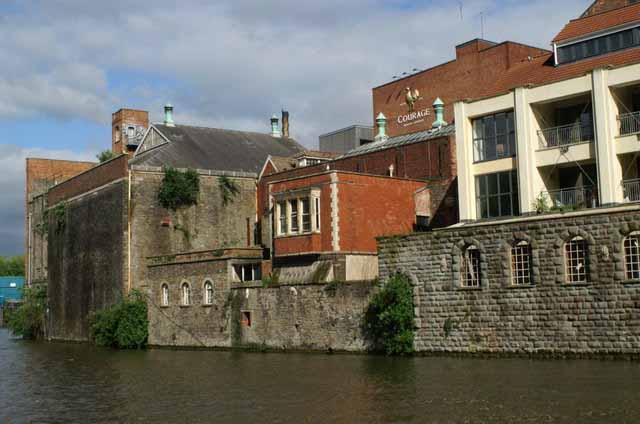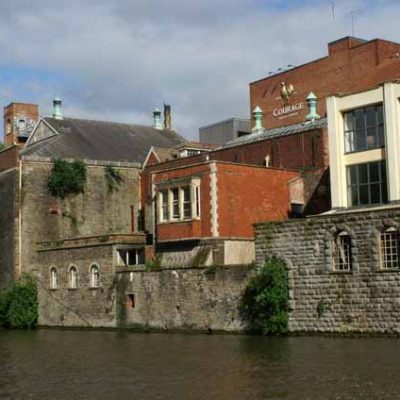

Ben Ford’s talk outlined the development of the Medieval city at Finzel’s Reach and focused on Medieval Archaeology. There is not much Post Medieval archaeology from excavation, but it can be seen in the surrounding buildings. The developers of the site intended for Temple Cross to be re-imagined in its new development.
The tidal range of the River Avon would reach Finzel’s Reach and also the River Frome. This was a defendable location between two rivers. Its origins are late Saxon. It was a sheltered area and ideal as a port. Bristol Bridge formed a barrier to larger sea-going boats and the smaller river boats. It is this area that has shaped Redcliff and Temple. East Tucker Street and Tucker Street are at the heart of Temple Cross where the passing of trade could be controlled and channelled towards Bristol Bridge. It was an influential port; the second largest after London.
Excavation:
The modern development is huge and archaeologists did a full building recording before excavation. Some building fronts were retained, such as Bristol Brewery, but mostly the buildings were swamped by the development.
The excavation covered either side of Temple Street and Tucker Street and down to Temple Backs. Through excavation the development of tenements were revealed up to Temple Cross. Archaeologists studied the various layers of alluvium and gravels that had been laid down on the site. The archaeological horizon was 2m deep and the ditches were 4m deep. It was the high water table that preserved valuable remains within its deposits, which otherwise would not have survived. These remains included timber.
The use of the area began in the late Saxon period around AD 950 – 1110 and the early Anglo-Norman period. In the late Saxon period, the bridge could be defended together with the area within the Law Ditch. There is no evidence for this, but the Law Ditch is 15m wide and 4m deep and is 10th Century at its base. An early cut of the ditch defines the area AD991-1152. This could have been a late Saxon defensive earthwork, as there is a hint of a ditch going round the bridgehead. The ditch was used as a boundary in the later period. By the 12th Century it was revetted and by the 13th Century a solid stone wall was added, to try and stop erosion at the back of the tenements. The land was being reclaimed so that it could be used for dwelling and artisan industry.
The area was owned by barons and Redcliff was the area of merchants. In the 12th Century Temple Fee was used by the Knights Templar to raise money for their Middle Eastern campaigns from rents from urban development. They dug ditches and drained the land to define a roadway and house plots on which tenements could be built and then they claimed the rentals. These are the first buildings on the site and are dendro-dated to AD 1099 – 1131 from a timber post. Metal deposits found in the ground suggest that in the 12th Century artisan smithing took place even though there was no evidence of hearths or furnaces. Later on secondary smithing was carried on. Many of the domestic houses have evidence of artisan activities, such as cloth production and dyeing. Cloth finishing was taking place at Tucker Street, with leather working on the east side of the area. Fullers’ teasels were recovered, together with plant material, such as madder, used in dyeing. Timber lined pits of different sizes suggested washing and dyeing was carried on in the tenements. East of Temple Street, tanning was carried out on a small scale. The evidence for this was found in timber barrels set in pairs into the ground. Clay was packed around the outside of the barrels to make them watertight. The anaerobic conditions perfectly preserved the barrels. Temple Cross was an ideal area for artisan industries, due to the immediate supply of water.
The finds:
Ham Green ware (1120-1300) – decorated with a zoomorphic figure.
Bristol Redcliff ware (1250-1500).
21,000 sherds of pottery were recovered from 52 Medieval and Post Medieval types and include Valencian lustre ware and Saintonge ware from a chaffing dish.
Iron key.
Tuning pegs.
A Middle Eastern bridge for a Rebec or lute.
Antler cross-bow nut.
By the late 14-15th Centuries more substantial stone properties are appearing with workshops adjacent to the Law Ditch. There are larger tenements, and many had cellars dug beneath them, which is not good for the preservation of the archaeology. Streets were paved and there are substantial buildings on the front with industry being carried on in the back. One structure in Temple Fee had four large hearths outside the back of the building. This was possibly cloth dyeing on an industrial scale, or even a bakery. No parallels have been found. Withies wrapped around barrels suggests that wine was being imported from Gascony. Marks around the bung hole of one of the barrels was a unique discovery. Unfortunately, there was no master chronology that matched the timber sample, in order to obtain a date from dendrochronology.
There is a gap between the Medieval activity and that in the Post Medieval period, which is more fragmentary. For the last 300 years the site was famous for its sugar refining which can be seen in the foundations of buildings used as a refinery. Brewing came into the area in the 19-20th Centuries, with Bristol Brewery and Courage Brewery next to the river. By the 18th Century the old Medieval cross roads went out of use.
Ford, B.M., Brady, K. and Teague, S., 2017, From Bridgehead to Brewery: The Medieval and Post Medieval Archaeological Remains from Finzel’s Reach, Bristol. Oxford: Oxbow Books.
Ben’s book can be bought from Oxbow Books: www.oxbowbooks.com/oxbow/

Former Courage’s Brewery in 2006
Copyright geograph.org.uk
